Onsite Non-Potable Water Reuse Resources
Onsite non-potable water reuse is water that is collected from onsite sources, such as greywater collected from a sink, appropriately treated, and used for non-potable applications at the single-building or water district scale. Applications can include toilet flushing, dust control, soil compaction, fire protection, commercial laundries, vehicle washing, street cleaning, snowmaking, and other similar uses. Onsite non-potable water systems can help to mitigate the demand on freshwater supplies and reduce the volume of water entering a sewer system, which can be especially helpful during flood events. By reusing water onsite, communities can lower their overall energy demands and carbon emissions, partially due to the reduced need to transport treated water great distances.
Water reuse is the practice of reclaiming water from a variety of sources, treating it, and reusing it for beneficial purposes. The following resources relate to onsite non-potable reuse; for information on other uses, please visit the Water Reuse Resource Hub by End-Use Application.
On this page:
Key Resources
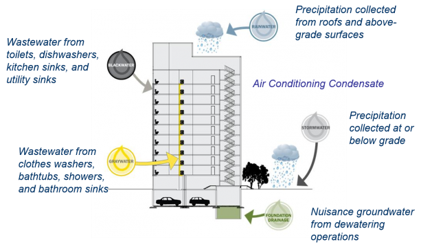
The following are a sampling of the key water sector resources that are freely available to support water practitioners interested in developing onsite water reuse projects. Visit the Water Reuse Information Library for additional water reuse materials.
- 2025 Risk Based Framework for Developing Microbial Treatment Targets for Water Reuse – This EPA document provides detailed scientific information that states and Tribes can use to develop risk assessments and microbial treatment targets that support safe potable and non-potable water reuse.
- National Blue Ribbon Commission Resources for Onsite Non-potable Reuse (2024). This list of resources is intended to support local implementation of onsite reuse by providing project examples, technical materials, program guidance, tools for regulation development, project financing options, risk benchmarks and more. Example resources include an e-book that provides practical knowledge and aims to inspire utilities and government leaders to consider implementing onsite non-potable water treatment systems and a 2023 report that outlines the state of the science for determining the level of treatment required for onsite water reuse systems.
- Onsite Water Reuse Summit Summary: Integration of Science, Policy, and Operation for Safe and Effective Implementation (2024). The EPA, National Blue Ribbon Commission for Onsite Non-potable Water Systems, and WateReuse Association collaboratively presented this summit, which included over 40 presenters and 200 attendees from across the country. Different parts of the water sector participated to share experiences, research, goals and success stories associated with implementing onsite water reuse systems. Presentation slides from the event are available online under the “Resources” section of the NBRC website. Find more relevant information through WRAP Actions 2.18 and 3.4.
- Texas Water Trade’s Net Zero Water Toolkit (2024). This web resource can help developers incorporate water reuse technologies in new buildings. Texas Water Trade uses this toolkit to collaborate with land developers and water providers to make buildings that capture, treat and reuse their own water the new state norm. Texas buildings that incorporate Net Zero Water strategies demand 75 to 90 percent less from shared water supplies than typical buildings.
- Guidebook for Commissioning an Onsite Water Treatment System in San Francisco (2022) – San Francisco Water Power Sewer created this guidebook that provides information to assist design engineers, treatment system managers, and other stakeholders involved in starting up the operation of an onsite water treatment system. It outlines the process for commissioning an onsite system, discusses stakeholder roles, and provides guidance on inspecting and testing individual treatment processes.
- Non-Potable Environmental and Economic Water Reuse (NEWR) Calculator (2021) – The NEWR Calculator is a simple web-based tool that can be used to identify the most environmentally- and cost-effective suite of source water options to meet non-potable needs based on ZIP code, climate, building size, and building type. EPA shared the NEWR Calculator in the Fit-for-Purpose Water Updates and Life Cycle Comparisons for Non-Potable Water Reuse Scenarios webinar (2021).
- Onsite Non-Potable Water System Guidance Manual (2020) – The document was published by The Water Research Foundation in coordination with the National Blue Ribbon Commission for Onsite Non-potable Water Systems to provide guidance for the operations, maintenance, and permitting of such systems. This guidance manual includes critical information for the design and implementation onsite non-potable water systems based on the risk-based framework previously developed.
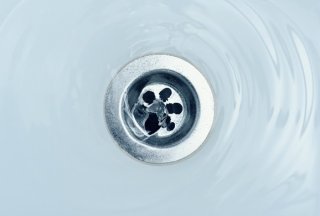
- Risk-Based Framework for the Development of Public Health Guidance for Decentralized Non-Potable Water Systems (2019) – This document was developed by an independent advisory panel to provide guidance on the technical, scientific, and regulatory aspects of onsite non-potable water systems. Recommendations are included on treatment requirements and a management framework for the use of onsite-treated water sources for non-potable applications.
State Water Reuse Regulations and Guidelines
The following states developed guidelines and regulations for onsite non-potable water reuse applications. Select the links to explore summary documents from the REUSExplorer, which include types of onsite non-potable reuse approved by each state, reuse specifications, laws and policies, and more!
Project Examples
Corkscrew Swamp Sanctuary treats wastewater onsite for toilet flushing (Southwest, Florida)
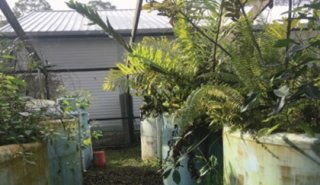
Corkscrew Swamp Sanctuary contains a system—a “Living Machine®”—that treats wastewater generated onsite from the facility restrooms and recycles it for toilet flushing, effectively reducing demand on potable, freshwater supplies and helping to conserve groundwater. As visitor attendance at the sanctuary increased, the amount of wastewater generated onsite also increased to a level beyond the capacity of the old septic system. The sanctuary responded by installing an innovative treatment system, the Living Machine®, that employs plants and microorganisms instead of a traditional onsite wastewater treatment system. The Living Machine® also provides other benefits, such as educating the sanctuary’s visitors about the ability of natural wetlands to improve water quality and being aesthetically appealing.
Developed by The World Bank in June 2023
Alaska Department of Environmental Conservation holds an onsite non-potable reuse competition to address rural water needs (Alaska)
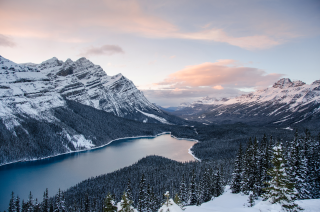
Thousands of residents in rural Alaska lack access to running water or flush toilets due to their remote locations and the local climate. To address this issue, the Alaska Department of Environmental Conservation (DEC) funded the Alaska Water and Sewer Challenge - a research and technology development competition intended to identify a suitable decentralized water reuse solution for use in rural Alaska homes. The DEC solicited designs that could safely and affordably supply homes with clean water but were also acceptable for the end users and feasible for implementation in rural Alaska. The winning design consisted of an onsite greywater recycling system coupled with urine-diverting dry toilets, which could significantly reduce the reliance on imported water for non-potable uses. Since the system avoided the use of water for flushing toilets, it limited the need to export sewage for treatment and disposal. As of this publication in June 2023, the selected design was progressing toward the implementation stage.
Developed by Jacobs in June 2023
Brooklyn, New York leverages new development project to reduce potable demand and improve sewer capacity (New York)
A new redevelopment project which is under construction in Brooklyn has incorporated reuse into its design. Specifically, this reuse project is part of the revitalization of the historic Domino Factory, and consists of a non-potable water reuse system which will collect and treat wastewater from five newly constructed buildings and reuse it for toilet flushing, cooling tower make-up and irrigation in three of those same buildings. Half of the treated wastewater will be reused onsite and the remainder will be discharged directly to the East River after treatment. Non-potable reuse will significantly reduce the demand on the water supply in the rapidly developing neighborhood by offsetting the use of potable water. Onsite treatment and reuse also mitigates the impacts of combined sewer overflows by diverting wastewater away from combined sewers and lowering pressure on downstream wastewater treatment facilities.
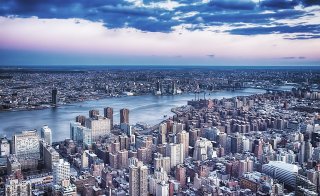
Developed by the NYC Department of Environmental Protection and EPA in October 2023
